The first women to hold elected office in the U.S. were school board members. More than 60 years before women’s suffrage was enshrined in the U.S. Constitution by the 19th Amendment, Marietta Patrick and Lydia Hall were elected to the School Board of Ashfield, Massachusetts.
Both women were teachers. Hall served for four years. Patrick was on the board for a year before stepping down to get married.
Given this history, it’s not surprising that school boards, unlike most other governing bodies in the U.S., have near gender parity. According to a K-12 Insight survey commissioned by NSBA, 51 percent of school board members are men, and 49 percent are women. (The population of the U.S. is 49 percent male and 51 percent female.)
But numbers don’t tell the whole story.
While there is not a lot of research specific to school boards, other political science studies have shown that, in general, women run for office for different reasons than men. They face different challenges and barriers. And when they’re on the board, they tend to speak out less often than men.
Why is it important to recognize these challenges? Boards that are aware of and break some of the barriers to serving and participating ensure that they are fully representative of the communities they serve.
“It’s hard to argue that you have a representative system when you have people left out based on gender, race, class, ethnicity,” says Susan Carroll, professor of political science and women’s and gender studies at Rutgers University as well as senior scholar at the Center for American Women and Politics of the Eagleton Institute of Politics. “Beyond the justice argument, women in our culture have different life experiences, and it’s important to have those experiences represented at the table.”
Politics and gender
More women are running for and holding elected positions. Certainly, Hillary Clinton’s presidential campaign in 2016 spurred more women to run for office, as did the 2017 Women’s March.
In the 2020 presidential election, at least three Democratic women were considered serious contenders for the nomination. One of those women, Sen. Kamala Harris, is now the Democratic candidate for vice president.
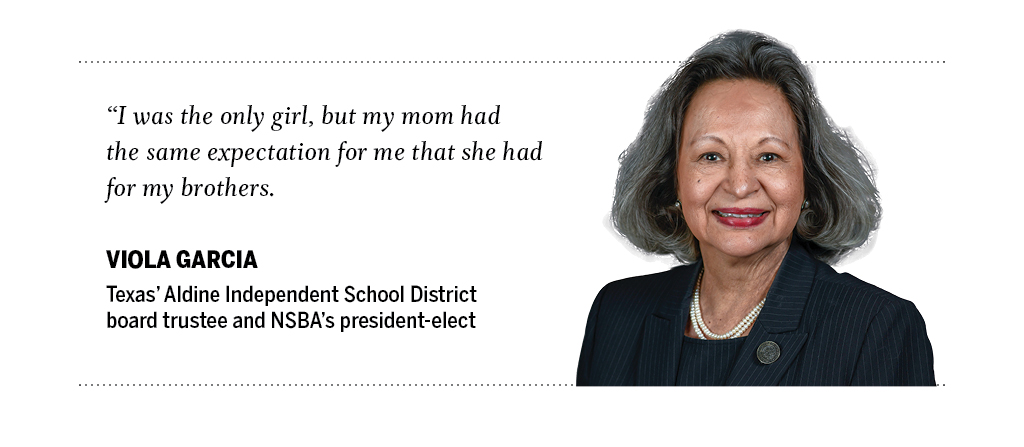
Despite these gains—and there have been many—politics continues to be largely seen as a male domain. Women who consider entering this arena face pressures from societal expectations: from their families, their peers, and their constituencies.
“Being a woman in a leadership position is like walking a tightrope,” says Nancy Chaires Espinoza. “We are expected to be aggressive, but the tolerance for women being aggressive is lower on the part of everyone. I balance it every day, every time I open my mouth and put pen to paper.”
Chaires Espinoza is a member of California’s Elk Grove Unified School Board. The district, 20 miles south of Sacramento, is the fifth-largest in the state. Chaires Espinoza was first appointed in 2015. She also worked in the advocacy department of the California School Boards Association.
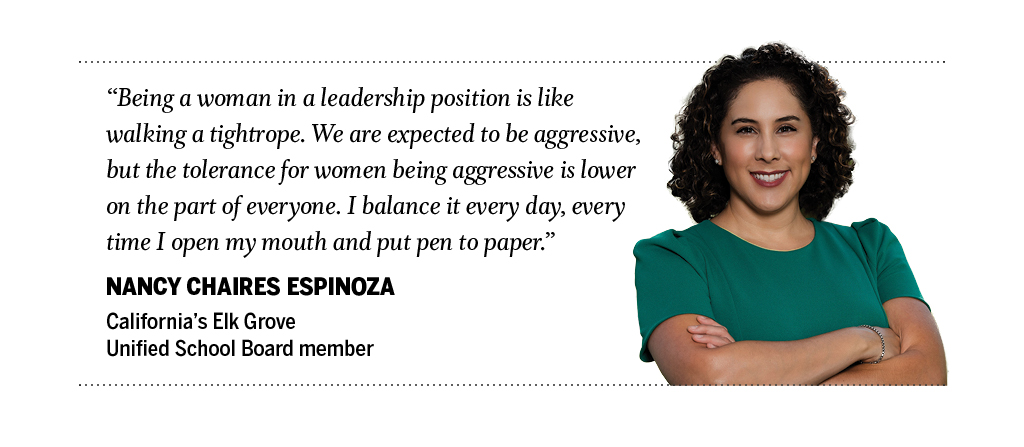
“It took a great deal of support and encouragement to persuade me to do it,” she says of her board candidacy.
Chaires Espinoza participated in a college program that she credits for helping her be prepared and motivated to run for office. “It put me in conversation with other women who had done it. The program normalized women running for office for me.”
The program, “From Harvard Square to the Oval Office: A Political Campaign Practicum,” was founded by Victoria Budson, executive director of the Women and Public Policy Program at the Harvard Kennedy School. The program recruits women from within the Kennedy School and gives them information, support, and encouragement to run for political office.
“In our society, women are expected to disavow ambition,” says Budson.
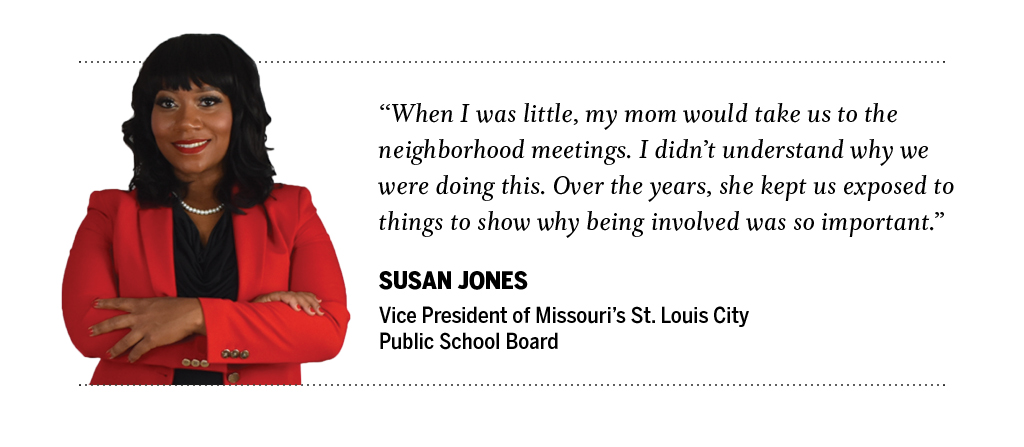
In addition to trying to appear unambitious, women face other challenges when running for any elected office, according to Budson. More attention is paid to their appearance, and they are asked more often about how they’ll be taking care of their children. Women with young children sometimes see that as a barrier for running for office.
Women believe they must be more prepared, more qualified to be candidates. “Women who run have stronger credentials than men. They are being held to a higher standard,” says Carroll. “Men have more ambition and see themselves as more qualified than women do, even when they have equal credentials.”
The perception of politics and campaigning can hold women back, as well.
“As women, we are getting a little better, but running for public office is a little scary, and you do have to have a thick skin,” says Leah Fliter, who served for eight years on a school board and is currently the advocacy and outreach specialist with the Kansas Association of School Boards (KASB). “We tend to think of ourselves as not as tough. Running is a hard and dirty job.”
| Information, research, and articles on women in leadership: Harvard Kennedy School Women and Public Policy Program Rutgers Center for American Women in Politics Barbara Lee Family Foundation |
Solving problems
Michelle McKissack volunteered as room mom in her son’s kindergarten class. Eventually, the former broadcast journalist moved to the PTA bylaws committee, then served as president. Someone asked her: Have you ever thought about running for school board? “I said, ‘I’m not a politician.’ She said, ‘You’d help more kids.’ That made me think.”
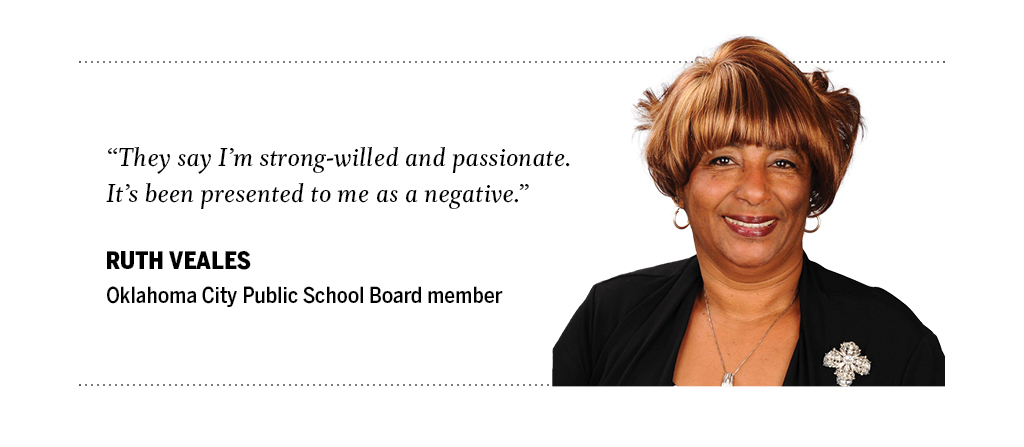
Ruth Veales worked for a police department when she noticed that the SROs were bringing in young men from two high-poverty schools with a large percentage of students of color. “What I saw was wrong,” she says. “They were preparing our children for incarceration, not higher education.” When she mentioned it to a judge, she was told, “You’ll have to talk to the Oklahoma City Schools.”
When her daughter started kindergarten, Margaret Nightengale wrote a letter to the school board about the district’s reorganization plan. In response, three school board members asked her if she’d consider running for a seat on the board. “I said, ‘No thanks,’” says Nightengale.
McKissack is a member of Tennessee’s Shelby County School Board. Veales is the longest-serving member of the Oklahoma City School Board. Nightengale is president of the Ulysses Public School Board in Kansas.
![A quote from margaret nightengale that says "I felt a greater responsibility when I was the only female on the board to make sure [the woman's perspective] was brought forward"](/-/media/ASBJ/2020/October/features/1020-F1-Quotes-for-website-Nightengale.jpg?la=en&hash=46095E70E2F1E458C276573D3977435D46B21C1E)
The stories of these three sitting school board members exemplify what research bears out: Women tend to run for political office for pragmatic reasons—to solve a problem. Like many women, they didn’t immediately see themselves as politicians.
Women don’t generally look in the mirror and see the next governor of their state, says Carroll, “until five people come up and say, ‘Why don’t you run for office?’ Women need more encouragement and support before taking that step. Women will report that they received more support and encouragement and that support was important to them.”
The support is much needed, as campaigning and serving can be more difficult for women than for men. “It’s such a tough thing to navigate. The public comments that come in, the complete disregard for your family,” says Verjeana Jacobs, who served 10 years on Maryland’s Prince George’s County School Board, six of those years as the board chair.
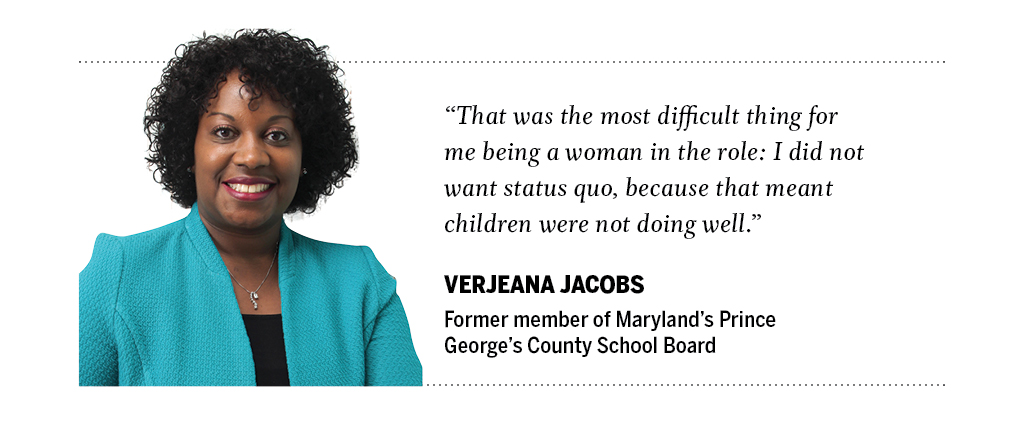
“In public life, you are exposing yourself,” she says. “Women are in a vulnerable position.”
In board service
“When I was growing up, my mother said, ‘You’re a woman and a Black woman. You’ll have to work twice as hard,’” says Karen Anderson Holman, a member of Virginia’s Winchester City Public School Board.
Holman has served on the Winchester board for six years. The Northern Virginia district with about 4,000 students is transitioning from an appointed to an elected board. Holman is a lawyer who works in her own private practice and serves as a guardian ad litem for the courts.
Women, she says, must do more to demonstrate their worth. “We overcome by being super prepared and super ready.” She’s noticed that women are criticized more harshly for asking a question at a meeting that showed she hadn’t read all the board documents. “We spend more time to overcome that perceived disadvantage than our male counterparts. It feels like women have to push twice as hard to accomplish the same thing. It’s a given that men have the knowledge because they are men.”
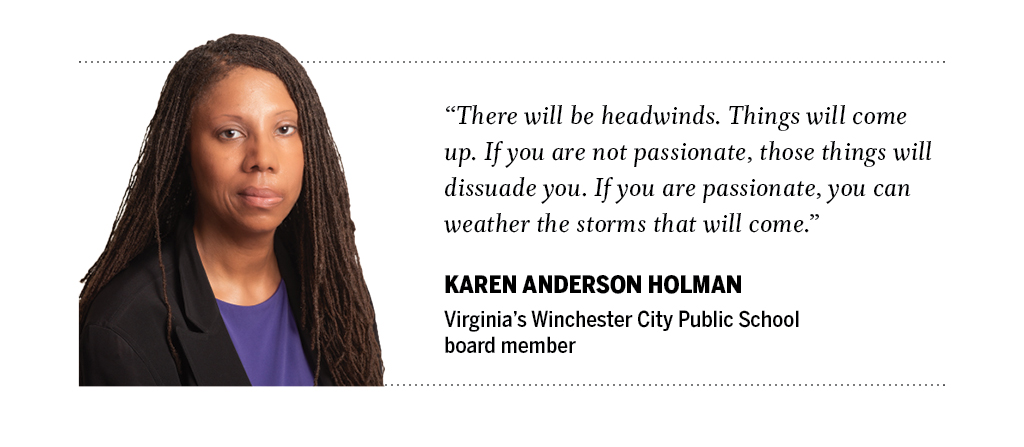
Susan Jones has served on Missouri’s St. Louis Public School Board since 2013. As the youngest person to serve as board president, she says some of the men on the board tried to intimidate her. “Sometimes they don’t want to accept it, and they don’t believe you can lead the way.”
She was criticized for her tone in group emails and teased about the way she talked. “My mom said to keep your head up and keep going. I keep this in my brain: The work I’m doing is not about me. This work is for a purpose much higher than me.”
Fortunately, she says, those individuals no longer serve on the board. In fact, the board is now majority female, and the dynamics have changed. “I’m not experiencing what I was experiencing. When we talk, our conversation is a bit more understanding.”
The notion that women speak up at meetings less frequently than men, and that they talk more when there are more women on board, is backed by research.
In a study that was published in their 2014 award-winning book, The Silent Sex: Gender, Deliberation, and Institutions, researchers Christopher Karpowitz, Tali Mendelberg, and their team studied group dynamics in a lab. Then they analyzed the minutes of school board meetings across the country in a representative sampling.
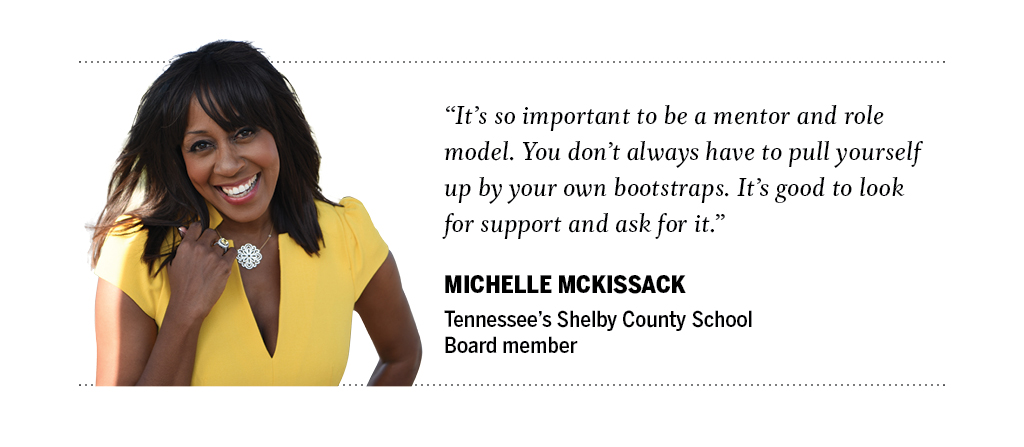
The lab group dynamic studies and the school board minutes yielded the same results, according to Karpowitz, who is the co-director of the Center for the Study of Elections and Democracy and a professor of political science at Brigham Young University. Mendelberg is the John Work Garrett Professor in Politics at Princeton University.
They found that women who were outnumbered on school boards participate less than what was expected given their representation on the board. In groups where women made up 10 percent of the board, they were taking up 5 percent or less of the conversation. “Their voices are dramatically underrepresented,” says Karpowitz.
As gender composition changes, women tended to participate more relative to their presence in the group. When women make up a larger composition, researchers didn’t find the same inequality of voice.
“The men in the lab and sample never experienced the same level of inequality of voice that women did,” says Karpowitz. “They never were underrepresented in the same dramatic way we saw with women.”
While both men and women can find board service intimidating at first, women feel the self-doubt that comes with not being able to see themselves in leadership positions, at least at first. “When I first got on the board, I was almost like a different person,” says McKissack. “I was shy and timid, not knowing whether I should speak up.”
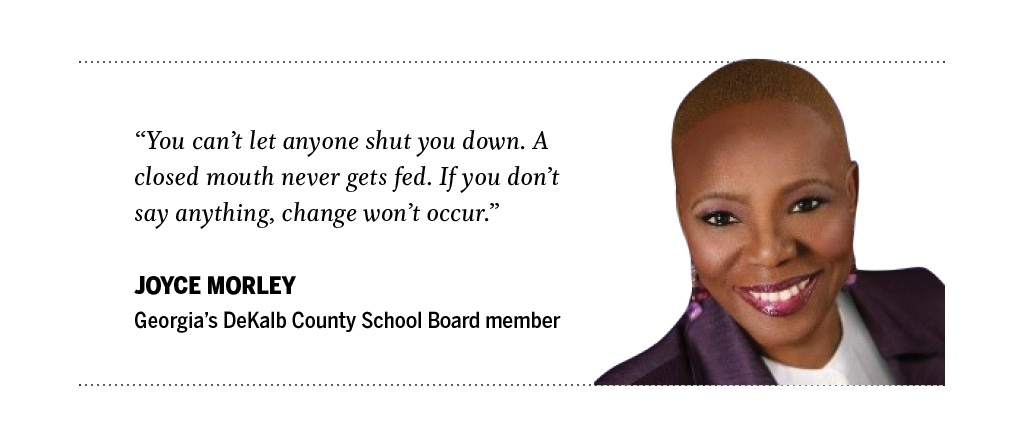
While implicit bias and social norms about gender play a role in board dynamics, another bias unfortunately can be a factor: race. “It’s been a challenge to be a Black female on the board,” says Joyce Morley, who has served on Georgia’s DeKalb County School Board for seven years. “Being an African American female with a doctorate degree has gotten in the way of some.”
When you’re a woman of color who rocks the boat on the school board, Veales says, you’re considered “overly aggressive and strong-willed—a troublemaker.” But, she says, she is undaunted because she was inspired to run by people telling her that the community needed leaders “who are not afraid to speak up.”
|
The Silent Sex In their study of women and school boards, professors Christopher Karpowitz, Tali Mendelberg, and their research team analyzed the minutes of school board meetings across the country and studied group dynamics in laboratory settings. The results were consistent and troubling: Women did not speak up as much in settings that were dominated by men. School boards can put some practices in place to prevent the underrepresentation of voices, but it will take awareness, especially on boards where women are in the minority. Bringing awareness to the dynamic can help. “We need to look at other types of remedies than elections,” says Karpowitz, the co-director of the Center for the Study of Elections and Democracy and a professor of political science at Brigham Young University. In the lab studies, when the decision-making was changed from majority vote to unanimity (where everyone must agree), the inequality was lessened because members got the message that every voice mattered. Making decisions this way takes a longer time and may be too cumbersome for school boards. “But boards could think about whether there are other things they could do, other rules they could follow, that send the message that we need to hear from everyone,” he says. For example, Congress has rules about participation in its committees. Each member gets at least five minutes on a topic. The rules make clear that the five minutes is the equal right of everyone. |
Mentoring, role models, and networking
“Managing Conflict and the After Effects,” and “Succeeding in a Male-Dominated Environment” were two of the many topics featured at KASB’s Women’s Leadership Summit in 2019.
The event, which was held with the United School Administrators of Kansas, was so popular and well-attended that another was planned for 2020 (but postponed until 2021 due to the pandemic).
KASB’s Fliter helped spearhead the effort with the Kansas school administrators. “Members were very excited about it,” she says. “Kansas is a big enough state geographically that it’s difficult to get to know your peers. When you have a daytime job and a family and other responsibilities, you don’t have a chance to network with female leaders. You don’t get to know them.”
The opportunity to network—to talk to other women leaders who face the same issues—is an essential element to the success of women on school boards. And women say that mentors played a role in their journey to the board and want to serve as mentors to other women.
Linda Daugherty credits two role models with her run for Missouri’s Nixa School Board: the city’s mayor and a Nixa school board member who’d served on the board for 30 years before retiring.
“It made such a difference for me, seeing them in service to their cities,” she says. “When you see it role-modeled as young women, it’s very influential.”
The school board member, Peggy Taylor, reached out to Daugherty and asked her to serve on an influential education committee. The current Missouri School Boards Association president says, “I wouldn’t have thought about being a board member had I not seen that modeled in front of me.” She says it’s important for women leaders to reach out to other women who would be good leaders. “We bring a different viewpoint. The only way to see that grow is if we begin to encourage the young ones.”
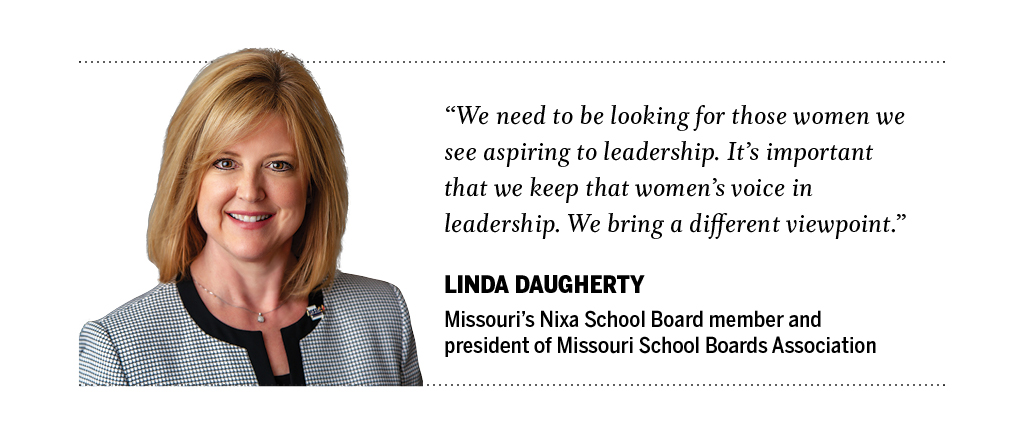
Women leaders are role models for their community: to their employees, parents, and students. Viola Garcia has served on Texas’ Aldine Independent School Board for 28 years and is NSBA’s president-elect. As a Latina, she says she is always aware of the perspective that she brings that may otherwise go unheard. “Students will say, ‘She will bring to the table a snippet of my voice.’”
Mentors don’t have to be on the school board, and they don’t have to be women, Chaires Espinoza says. “I’ve been grateful to be mentored by both men and women who have been incredibly supportive. It’s a lonely endeavor to run for office, and it’s especially lonely for women. It’s important to have that sounding board. “
At the table
At the end of July, the Manhattan-Ogden Public School Board met to discuss a weighty issue: plans for reopening schools in the midst of the pandemic.
The discussion about whether to hold classes in-person or online took up most of their conversation. Board President Karla Hagemeister and another female board member talked after the meeting about how important it was to have their viewpoints heard during the debate.
“Generally speaking, the mom is staying awake at night wondering how to make this work,” she says. “It was not lost on us sitting at the table that there’s going to be a lot of moms trying to figure this out.”

School boards represent their communities. Members strive to bring the considerations of parents, students, employees, and the community when they make decisions. Why is it important to hear women’s voices?
“We have a place for all viewpoints at a board table. We are better when all those voices are heard. Whether it’s race, gender, ethnicity, sexuality, having a diverse group of people at the table is helpful,” says Hagemeister.
Holman agrees. She brought an important perspective as the only single mother on her board. “I was the only one on the board paying for babysitting during board meetings,” she says.
However, she says, being a single mother, or having any other type of diversity or life experience, isn’t a reason not to serve on a school board. In fact, she says, it’s an incentive to serve. “That’s a perspective that’s lost otherwise.”


Share this content